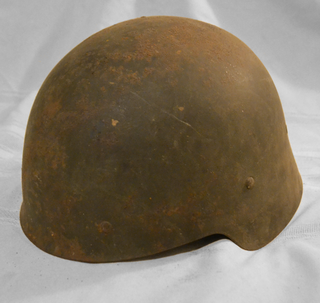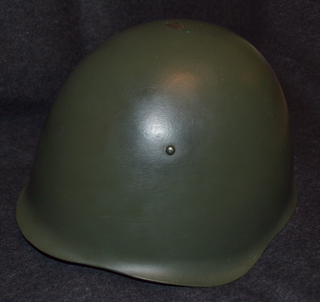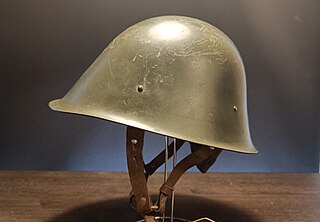
The Brodie helmet is a steel combat helmet designed and patented in London in 1915 by Latvian inventor John Leopold Brodie. A modified form of it became the Helmet, Steel, Mark I in Britain and the M1917 Helmet in the US. Colloquially, it was called the shrapnel helmet, battle bowler, Tommy helmet, tin hat, and in the United States the doughboy helmet. It was also known as the dishpan hat, tin pan hat, washbasin and Kelly helmet. The German Army called it the Salatschüssel. The term Brodie is often misused. It is correctly applied only to the original 1915 Brodie's Steel Helmet, War Office Pattern.

The Stahlhelm is a German military steel combat helmet intended to provide protection against shrapnels and fragments or shards of grenades. The term Stahlhelm refers both to a generic steel helmet and more specifically to the distinctive German military design.

The M1 helmet is a combat helmet that was used by the U.S. military from World War II until 1985, when it was succeeded by the PASGT helmet. The M1 helmet has become an icon of the US military, with its design inspiring other militaries around the world.

The hełm wz. 31 was the basic combat helmet of the Polish Army before the outbreak of World War II and during the Invasion of Poland. The helmet became the basic type of combat headgear for Polish military formations in the 1930s and during the early stages of World War II. It was also exported to Persia, Albania and Republican Spain. By September 1939 approximately 320,000 helmets were delivered to the Polish Army.

The helmet cover was first used by French soldiers during World War I.

The Mk III Helmet is a steel military combat helmet that was first developed for the British Army in 1941 by the Medical Research Council. They were issued to troops in April 1944 and then worn in combat for the first time by British and Canadian troops on D-Day. Mk III and Mk IV helmets were used alongside the Brodie helmet for the remainder of the Second World War. It is sometimes referred to as the "turtle" helmet by collectors, because of its vague resemblance to a turtle shell, as well as the 1944 pattern helmet.

The following is a general overview of the Heer main uniforms, used by the German Army prior to and during World War II.

The m/26 helmet is a steel helmet that was almost exclusively used by the Swedish Civil Defense, "Civilförsvaret".

The M32 helmet also known as M32/34 is a military steel combat helmet used by Czechoslovakia from its adoption in 1932 to its annexation by Nazi Germany in 1939. The helmet also being used by the Slovak Republic and Finland among other countries that the helmet would be worn by.

The M1918 helmet is a steel military combat helmet used by Switzerland from its introduction in 1918 to its replacement by the M1971. In 1943 improvements would be made to the design to which it would be called the M1918/40. The helmet would be seen used by Swiss servicemen until the late 20th century.

The M1971 helmet is a military steel combat helmet used by Switzerland from its formal introduction in 1971 until its gradual replacement by the Schuberth B826.

The M1942 helmet is a military steel combat helmet used by Spain from its adoption in 1942 to its replacement by a Spanish M1 copy in the 1980s.

The M1926 Helmet, also known as the M26 and “Con ala” for its flared sides compared to the earlier M1921 model helmet, is a steel combat helmet used by Spain from its adoption in 1930 until its replacement by the M42 in 1942. The helmet would be a common sight along with many other helmets between both sides in the Spanish Civil War.

The M1921 Helmet, also known as the M21, along with “Sin ala” for its vertical sides, is a steel combat helmet developed alongside the M1926 helmet in 1926 for use by the Spanish Army. The model was never formally adopted, with the army deciding in favor of the M1926. The exact reasoning for the designation "M1921" is not known as it was developed later.

The M70 is a steel combat helmet used by Hungary, a license made copy of the Soviet SSh-40 and further development of the previous model M50 helmet.

The M1934 helmet is a steel combat helmet used by various factions in the Spanish Civil War. Not meant for use by the Spanish Army, but instead by security forces such as police, the helmet was of similar shape to the Model 1926 helmet in use by the army. The helmet was mainly used by the Nationalists in the conflict.

The Wz50 also known as M50 is a steel combat helmet used by Poland from its introduction in 1950 to its replacement by the Hełm wz. 67 in 1967. The helmet would be widely exported to a number of Arab countries for its low price. Early pre-production helmets by a double riveted chinstrap and cow skin leather liner. All models of helmet would include an maker and manufacture stamp

The M34 is a steel combat helmet used by the Netherlands from its introduction in 1934 replacing the previous M23/27, to the invasion by Nazi Germany in 1940. From which it was replaced by the M53 helmet, a local copy of the American M1 helmet. A tropical variant of this helmet was produced for use by the Dutch East India Army in present-day Indonesia known as the KNIL model.
The SSh-39 and SSh-40 were two similar designs of steel combat helmet designed and used by the Soviet Union's Red Army. They were the main forms of helmet in use during World War II and had only superficial differences.

Romanian Helmet Model 1973 - Romanian steel helmet used by the army of Romania, introduced in 1973 in the Army of the Socialist Republic of Romania.






















